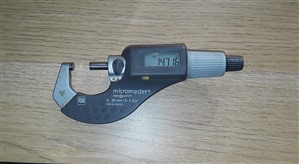


davezawadi (David Stone):
OK ebee, fair enough to suggest that a vernier is not really accurate enough, but is accuracy the problem, it more likely to be resolution. Here is a picture of a fairly modern digital micrometer, resolution 1 microm (1/1000 mm). Its accuracy is usually +- 2 or 3 microns.
Now we need the diameter of the wire, the number of the cores:
BASEC 4mm LSF Dia 0.819mm radius 0.4095mm
BASEC 2.5mm PVC Dia 1.721 radius 0.8605mm
Earth core of 2.5 dia 1.340mm radius 0.67mm
Lets work out the cross sectional area. pi r2 sq mm.
4mm 0.4095 squared times pi times 7 (wires) = 3.687701202 sq mm.
2.5 0.8605 squared times pi times 1 (wire) = 2.326224482 sq mm.
1.5 0.067 squared times pi times 1 (wire) = 0.1410260942 sq mm.
Do you notice anything interesting? It is not that the micrometer is inaccurate, it is that cables are "nominal" sizes and manufactured to a resistance specification. If the copper is purer than the size in sq mm warrants the diameter may be reduced to get to the specification. This is purer copper than the spec, so the sizes are reduced because copper is very expensive yet easily drawn to any needed size. I have deliberately made a mistake with the above numbers, can anyone see what it is? (The measurments are correct).
Doing the same measurments with a digital caliper high quality, expensive, gives (diameters)
4.0mm 0.79mm 1 core
2.5mm 1.70mm
1.5 mm 1.30mm
A Powerfix digital caliper from Lidl < £20, sometimes £9.99, but these may be the less good ones:
4.0mm 0.79mm 1 core
2.5mm 1.74mm
1.5 mm 1.29mm
Not too bad really, but making the measurments depends on also measuring a dead straight part of the cable, or taking multiple readings 90 degrees apart (Real wires are not quite round) and averaging. One should not peasure with the "knife" end of the caliper, but the wide flat part. The knives are thin and varying the pressure will change the reading due to the spring in the copper.
One should correctly identify each of the above cables, but knowing if they are metric is more difficult. That is why the marking is of use, usually impressed on the sheath. Now the question for Stuart, no offence meant BTW, is the aparent cable diameter more than a guide, and how much does it really matter? I outlined above why it may not talking about the EICR, and unless you accurately know the cable resistance and length (not often for an EICR) it is very difficult to decide if it is really undersized. Careful use of a digital vernier (it takes a lot of skill to work to the resolution of a mechanical vernier one, even if it is absolutely accurate which if not new it it is unlikely to be, wear of 100th of a mm does not take long, we can usually get an idea of a cable size. Oddball ones may also me manufactured too small, which is why the "evidence of overheating" is very important.
I hope all that was of some interest to all.
David
David many thanks for this information its much appreciated. I will take your comments on board.My original post was a bit misleading. At the time all I saw was the cu with the cover off and the cables terminated into the MCBs and noticed that the radials fed from 32A mcbs. Its a MEM Memera unit so I assume the installation will be older than the 30 years my friend told me.
again many thanks
Stuart
We're about to take you to the IET registration website. Don't worry though, you'll be sent straight back to the community after completing the registration.
Continue to the IET registration site